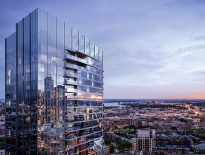
Architects Stull & Lee designed public realm spaces at the 1,055-room Omni hotel which broke ground last week at 440 Summer St. in Boston. Rendering courtesy of Elkus Manfredi Architects.
Rarely does a mature city find the opportunity to re-shape a major portion of its landscape at the scale of the emerging Seaport neighborhood. Not since the filling of the Back Bay has Boston experienced such an opportunity.
Arguably but perhaps fortuitously, it takes decades for an area this large to take shape. The world’s great urban places are often the result of long periods of organic growth, often in fits and spurts, as they evolved to become vibrant, interesting places that appeal to the local populace and attract tourists from around the world who visit and when possible, book hotels in or as close to such lively precincts as possible.
In classic U.S. cart-before-the-horse fashion though, we have begun to build out the Seaport District on a project by project basis, but the shaping of the public realm lags. In the long run though, it is precisely the thoughtful and creative crafting of the public realm that provides the connective tissue and is the sine qua non necessary to achieve world-class destinations.
Today with the trending isolation among us that social media increasingly facilitates, it may be more important than ever to provide environments where people can actually meet and interact in real time and space.
Enter Massport
Owners of 30 acres in the Seaport area, most currently in use as surface parking, the Massachusetts Port Authority is exercising considerable and laudable civic zeal to create conditions and give the nod to developers and their teams inclined to design new buildings on Massport land that contribute to a larger vision of what a great city place can be.
In its requests for proposals, Massport pointedly encourages design strategies that not only allow for a respectable return on investment but provide for public open space, new public facilities and art and performance venues as well.
As each new parcel is developed going forward, it is vital that a continuing and robust dialog occur between each development team to consider how best each project can enhance the public realm beyond discrete parcels. It is also imperative that the city and the state work cooperatively to promote and nurture such dialog and make necessary and timely, strategic public sector infrastructure investments.
To that end, now is the appropriate time to consider reconstruction of the current “street” network which I suggest is more of a “road” network designed initially to serve the district when it was more industrial in character. What the area needs now in my view is an aggressive “roads to streets” initiative that reconsiders the geometry and width of the street and roads including the number and configuration of the highway ramps that serve the area.
In addition to the geometry of the roads and streets, equally important are creative land use decisions and stewardship of the pedestrian realm aided and abetted by building designs that include active ground floor uses, frequent points of entry, transparency and inviting streetscape and landscape designs.

David Lee
A Challenging Site
In the design of the new Omni hotel on Summer Street, a great deal of effort has gone into thinking about how to address the enhancement of the surrounding public realm while dealing with considerable site constraints. Obviously, a hotel must accommodate a healthy contingent of guests who will arrive by private cars or taxis, not to mention tour buses which can prove disruptive to a safe and inviting pedestrian oriented environment
The design of the new hotel takes on these challenges including taxing grade changes with a system of artfully considered ramps and steps enhanced by the employment of interesting paving materials and landscape gestures.
In the design of the building itself, the second, third and fourth levels feature terraces, outdoor decks and vast areas of glass which will emit light and offer glimpses of activity inside. At the ground level, the operators are programming a series of inviting uses including restaurants, cafes and retail spaces that will bring much needed life and activity to Summer Street, World Trade Center Avenue and D Street, well into the night.
Although every attempt is being made to accommodate automobiles, the site is well served by a Silver Line stop which goes directly to the airport, and South Station is a short walk or cab ride away.
Ultimately though, as an urban designer and a local, it is my hope that with the hotel and Convention Center, in concert with other well considered development in the district as catalysts, the neighborhood will become in the words of baseball legend Yogi Berra “… so crowded, nobody goes there anymore.”
That will be a great neighborhood.
David Lee is a partner at Boston-based Stull and Lee Inc.




 |
| 
